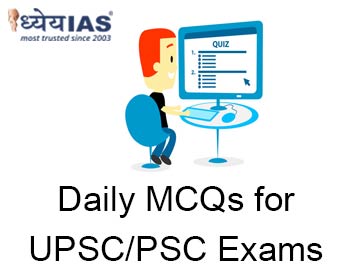Home > Daily-mcqs
Daily-mcqs 31 May 2025

Q1:
With reference to ancient Egyptian necropolises, consider the following statements: Which of the above statements is/are correct?
A: 1 and 3 only
B: 2 and 3 only
C: 1 only
D: 1, 2 and 3
Answer: A
Explanation:
Statements 1 and 3 are correct. Necropolises were large burial grounds for royals and elite officials, typically located outside urban areas for religious and sanitary reasons. Tombs often featured architectural elements like courtyards, transverse/longitudinal halls, and burial wells. Statement 2 is incorrect — Dra Abu al-Naga is a New Kingdom non-royal site, not known for Old Kingdom pyramids.
Q2:
Consider the following pairs: Cyber Fraud Type Description Phishing Using fake emails or messages to trick users into sharing sensitive data Vishing Voice-based social engineering to obtain confidential details Shoulder Surfing Gaining passwords by watching users enter credentials in public Juice Jacking Malware injection through charging ports in public places Which of the above pairs are correctly matched?
A: 1, 2 and 3 only
B: 2, 3 and 4 only
C: All four
D: 1, 3 and 4 only
Answer: C
Explanation:
All four are correctly matched. These are distinct fraud tactics:
Q3:
Which of the following best explains the term “dark patterns” in digital commerce?
A: User interface designs intended to increase page engagement time
B: Automated cyberattacks targeting e-commerce payment gateways
C: Interface tricks that mislead users into unintended actions such as purchases or subscriptions
D: Visual cues designed to make web content more accessible to persons with disabilities
Answer: C
Explanation:
Dark patterns are intentionally manipulative user interface designs used in digital platforms to coerce or mislead consumers — e.g., false urgency, hidden costs, or auto-opt-ins. These are widely criticized for violating consumer rights and are now explicitly banned under India's Consumer Protection Act, 2019 through the Dark Patterns Guidelines, 2023.
Q4:
Which of the following best explains the public health significance of the “thin-fat syndrome” found among school children?
A: It confirms that malnutrition is no longer a major issue in urban India.
B: It shows that childhood obesity can be prevented by reducing calorie intake alone.
C: It demonstrates that normal weight does not necessarily indicate metabolic health.
D: It supports the elimination of physical education from school curricula to prevent body shaming.
Answer: C
Explanation:
The "thin-fat syndrome" or MONW (Metabolically Obese, Normal Weight) reveals that many children with normal BMI still have poor metabolic indicators, such as low HDL, high triglycerides, or insulin resistance. This debunks the myth that weight alone determines health and highlights the need for more comprehensive health screenings and lifestyle interventions beyond weight-centric models.
Q5:
Read the following statements carefully and choose the correct option: Assertion (A): Survival rates for breast cancer in India are lower than in Western countries.
Reason (R): The majority of patients in India are diagnosed at late stages of the disease.
A: Both A and R are true, and R is the correct explanation of A
B: Both A and R are true, but R is not the correct explanation of A
C: A is true, but R is false
D: A is false, but R is true
Answer: A
Explanation:
The survival rate for breast cancer is significantly lower in India compared to high-income countries. This is primarily due to the fact that over 60% of breast cancer patients in India are diagnosed at Stage 3 or 4, when the disease has already progressed and treatment outcomes are poorer. In contrast, early-stage diagnosis—common in countries like the U.S.—greatly improves survival chances. Therefore, both the assertion and the reason are true, and the reason correctly explains the assertion. Late diagnosis remains a critical barrier to improving breast cancer outcomes in India, underscoring the need for robust screening and early detection systems.